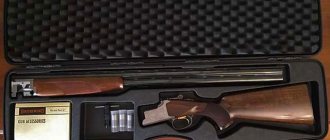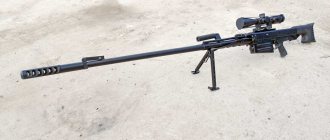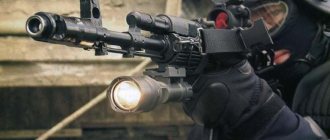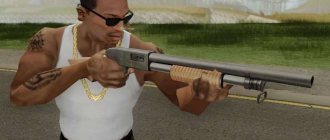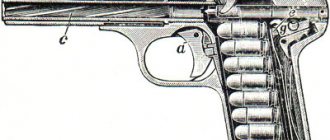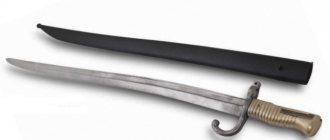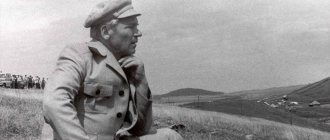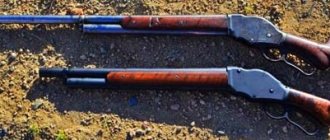The legendary gunsmith engineer John Browning began developing a self-loading gun for hunting back in 1898, and soon he assembled his first prototype and tested it in practice. At that time, hunters used classic single-barreled or double-barreled shotguns, and repeating shotguns with quick manual reloading were just appearing.
Developed by an engineer, the Browning Auto 5 self-loading rifle was the first self-loading shotgun in the world to be mass-produced.
Browning Auto 5 is an icon of many generations of hunters around the world, the world-famous first serial self-loading weapon for hunters. Browning Auto 5 was developed by Browning in 1898, patented in 1900, and was produced unchanged for a hundred years, and for this reason is listed in the Guinness Book of Records. The gun has gained popularity due to its large magazine capacity, automatic reloading, excellent workmanship and reliable automatic operation.
Browning Auto 5 was produced in a huge circulation of about 3 million copies over a hundred years. The gun, produced by arms factories in Belgium, the USA, Italy and even Japan, served as the basis for numerous imitations in various countries.
Development and creation
During development, several versions of a self-loading gun appeared, where the recoil energy of the barrel was used for reloading. The cartridges were used with smokeless powder. The most promising last option was chosen for further development. It differed from its predecessors in its high performance and more successful design. It was decided to bring it to mass production. After a short period of improvement, the self-loading rifle project was completed and offered to a potential manufacturer. In addition, the designer filed a number of applications for registration of inventions and received four patents.
A little later, after the start of mass production, the new gun received the symbol Browning Auto-5. This name reflected the possibility of automatic reloading, and the number indicated ready-to-use ammunition in the form of four rounds in the magazine and one in the chamber.
Initially, Browning Auto 5 was planned to be sold as a development to Winchester, which by that time had acquired 44 weapon systems created by Browning. But the plant management, represented by Bennett, refused, due to the weak prospects of these weapons. The second company, Remington Arms Co., also gave a negative answer. The famous designer turned to the Belgian company Fabrique National, where the production of his pistols had already been established. The new development was received positively, and Braunig placed an order for the first batch of ten thousand firearms for subsequent sale in America.
The very first copy of this weapon model, serial number 1, was sent to John Moses Browning on September 17, 1903.
All guns were sold out within one year. Soon the designer asked Fabrique National to partially transfer the right to produce and sell the new gun to Remington Arms, which immediately launched the production of Remington Model 11 guns, which were practically no different from the Belgian version.
The Browning gun turned out to be the most successful and widespread not only for its time, but also throughout the twentieth century. During the Second World War, the gun performed well in battle.
Specifications
- caliber, mm – 12/76;
- Browning gun length, cm – 116, 131 (depending on the model);
- barrel length, cm – 66, 71, 76 (depending on the model);
- weight without ammunition, kg – 3.38;
- number of charges, pcs. – 4 + 1;
- type – self-loading;
- sight - open mechanical, front sight above the muzzle.
Three versions were created for Browning auto 5
Application
The main users of the new guns were hunters and sports shooters. The ability to fire multiple shots without the need for constant manual reloading has become a noticeable advantage over other guns of the same class. Such advantages often became a decisive factor in the purchase, capable of leveling out a noticeable difference in price.
In addition, self-loading rifles have attracted the attention of several armies. For example, during the interwar period, a significant number of Belgian-made Auto-5 shotguns were purchased by the British Army. Having analyzed the experience of the First World War, in which some armies used trench brooms, such as the Winchester M1897 shotgun, the British military decided to strengthen infantry units with self-loading rifles.
In the British Army, Browning Auto-5 shotguns were designated L23A1. During the Second World War, this weapon was actively used in various operations, primarily in the fight against Japanese troops in Southeast Asia. The guns remained in service after World War II.
The method of using J.M.'s guns is interesting. Browning, used in US military aviation. The guns were mounted on special machines that imitated the machine gun mounts of bombers, which made it possible to carry out initial training of shooters.
This approach made it possible to practice weapon aiming with significant savings in ammunition. A number of Auto-5 rifles have also been used in infantry service for a long time.
Links[edit]
- ^ a b c d Leroy Thompson. US combat shotguns
. Osprey Publishing. paragraph 72. ISBN 178096014X. - ↑
Chris Cox (April 3, 2002).
Fireforce: One Man's War in the Rhodesian Light Infantry
(ed.
1
July 2001). Kovos Day. pp. 31–141. ISBN 1-919874-32-1. - McNab, Chris (2009). Firearms
. Queen Street House, 4th Queen Street, Bath BA1 1HE, UK: Parragon. item 277. ISBN. 978-1-4075-1607-3.CS1 maint: location (link) - ^ a b c d Wallach, LR. "Sixty million guns." 1983. In Gun Digest Treasury
, Harold A. Murtz, editor of DBI Books. 1994 p.194 ISBN 0873491564 - Firearm Model History - Remington Model 11 Archived November 14, 2010, at the Wayback Machine
- “Where are Browning firearms made?” . browning.com
. Retrieved June 6, 2022. - "Archival copy". Archived from the original on 2010-12-23. Retrieved 29 December 2010.CS1 maint: archived copy as title (link)
- https://www.browning.com/support/owners-manuals.html
- Philippine Army Weapons Systems Handbook
. International business publications. paragraph 116. ISBN 1433061988. - Neil Grant (2015). Rhodesian Light Infantry: 1961–1980
. Osprey Publishing. pp. 17, 22, 39. ISBN 978-1472809629.
General description of Browning Auto 5
Browning's use of a new principle of automatic operation - recoil of the barrel during a long stroke - determined the characteristic features of the new product:
- locking the barrel bore with a swinging cylinder (stop);
- combining the functions of feeder and shutter delay in one mechanism;
- control of the operation of stopping cartridges with a movable barrel;
- shock release of the bolt from the bolt stop using the rim of the next cartridge case;
- operation of the trigger without forced separation of the trigger and sear;
- regulation of the rollback speed of the moving parts by the friction brake of the recoil device, depending on the power of the cartridge used and the ambient temperature;
- extraction of the cartridge case when the barrel is returned to the forward position, when the pressure of the powder gases in the barrel drops to atmospheric;
- manual shutdown of the magazine.
The new Browning smoothbore self-loading shotguns were developed taking into account the experience of creating other systems that have a manual reloading option. For example, the general layout was taken from other samples. A magazine with a forend and a barrel located on it is attached to the front of the box. A butt of the desired shape is attached to its rear part. This rifle architecture subsequently created the opportunity to carry out certain upgrades regarding the ergonomics of the system, without introducing significant changes to the internal mechanics.
In the first project of a smoothbore weapon, designer John Moses Browning envisioned equipping the gun with wood fittings. An under-barrel forend and a butt with a protrusion in the shape of a pistol grip were used. In the applied neck, it was planned to install a small-diameter channel running deep inside the part. This is where the casing with the bolt spring located in it, responsible for the return, should have been located.
The basic version of the Browning Auto 5 was equipped with a 12-gauge barrel and could handle the appropriate shotgun loads. Subsequently, variants of guns began to be created that were suitable for other 16 and 20 caliber cartridges. The creation of such models was made possible thanks to successful automation, capable of adapting to firing ammunition with different characteristics.
Photo Browning Auto-5
Similar
AK-47 assault rifle cartridge caliber 7.62 mm. Device. Rate of fire
AK-74 assault rifle cartridge caliber 5.45 mm. Device. Rate of fire
Dragunov SVD sniper rifle caliber 7.62 mm. Device
AKS-74U assault rifle cartridge caliber 5.45 mm. Device. Weight
Mauser K96 pistol cartridge caliber 7.63 and 9 mm. Device
Pistol Walter PP / PPK cartridge caliber 7.65 and 9 mm. Device
Pistol Yarygin PYa Grach cartridge caliber 9 mm. Device
DShK machine gun cartridge caliber 12.7 mm. Device. Rate of fire
Luger pistol R.08 Parabellum cartridge caliber 9 mm. Device
Pistol PM cartridge caliber 9 mm. Rate of fire. Dimensions. Bullet speed. Sighting range
Self-loading shotgun Saiga-12 cartridge, caliber. Device
Maxim machine gun cartridge caliber 7.62 mm. Device. Weight
PPSh-41 Shpagina submachine gun cartridge caliber 7.62 mm
APS Stechkin pistol cartridge caliber 9 mm. Device
Nagan system revolver cartridge caliber 7.62 mm. Device
Kalashnikov PK machine gun and PKM cartridge caliber 7.62 mm. Device
Simonov carbine SKS-45 cartridge caliber 7.62 mm. Device
Rifles and carbines Mauser 98 caliber 7.92 mm. Device
PPS-42 and PPS-43 Sudaev submachine gun cartridge caliber 7.62 mm
Pistol Walter P38 cartridge caliber 9 mm. Device
MP-40 German submachine gun cartridge caliber 9 mm. Device
VSS Vintorez sniper rifle caliber 9 mm. Device
Submachine gun PP-91 Kedr cartridge 9 mm caliber. Device
Light machine gun RPK-74 cartridge caliber 5.45 mm. Device
Pistol Glock 17 cartridge caliber 9 mm. Device
Makarych, Izh-79-9T, MR-79-9TM, MP-80-13T traumatic pistol
AK-12 assault rifle cartridge caliber 5.45 mm. Device. Weight
Mosin rifles and carbines Three-line caliber 7.62 mm
PMM Makarov pistol modernized 12 rounds. Device
Revolver Colt Single Action Army (SAA) Peacemaker. Device
Machine gun PKP Pecheneg cartridge caliber 7.62 mm. Device
Sniper rifle VSSK Exhaust caliber 12.7 mm. Device
Beretta pistol 92 cartridge caliber 9 mm. Device
TT - Tokarev pistol cartridge caliber 7.62 mm. Device
Submachine gun PP-19 Bison cartridge caliber 9 and 7.62 mm. Device
Sniper rifle SV-98 caliber 7.62 mm. Device
Vladimirov KPV machine gun cartridge caliber 14.5 mm. Device
ASH-12 assault rifle cartridge caliber 12.7 mm. Device. Rate of fire
PSM pistol cartridge caliber 5.45 mm. Device
Pistol Colt M1911A1 cartridge caliber 45. Device
Smith-Wesson revolver Russian cartridge, caliber 10.67 mm. Device
Degtyarev DP-27 light machine gun, 7.62 mm caliber cartridge. Device
Shotgun Mossberg 500 Cartridge. Dimensions. Rate of fire. Sighting range
Thompson submachine gun cartridge caliber 11.43 mm. Device
Pistol USP Heckler und Koch cartridge, caliber. Device
Hunting carbine OSK-88 (SVT-40) caliber 7.62 mm. Device
AS Val silent automatic cartridge caliber 9 mm. Device
Submachine gun PP-19-01 Vityaz cartridge 9 mm caliber. Device
Machine gun Kord cartridge caliber 12.7 mm. Device. Weight. Sighting range
Osa - traumatic pistol cartridge, caliber. Device
AK-9 assault rifle cartridge caliber 9 mm. Device. Rate of fire
Degtyarev RPD light machine gun, 7.62 mm caliber cartridge. Device
Automatic OTs-14 Groza cartridge caliber 9 mm and 7.62 mm. Device
Czech pistol CZ-75 (modifications). Device
Browning pistol 1903 cartridge caliber 9 mm. Device
Sniper rifle OSV-96 caliber 12.7 mm. Device
FN P90 submachine gun cartridge caliber 5.7 mm. Device
Submachine gun OTs-02 Cypress cartridge caliber 9 mm. Device
Sniper rifle ASVK Kord caliber 12.7 mm. Device
Automatic AEK-971 Cartridge. Caliber. Device. Rate of fire
Steyr AUG assault rifle (A1, A2, A3) cartridge caliber 5.56 mm
AK series 100 assault rifles. Modifications. Device. Weight. Dimensions
Uzi submachine gun. Cartridge. Caliber. Rate of fire
Pistol SR1M Gyurza cartridge caliber 9 mm. Device
Pistol GSh-18 cartridge caliber 9 mm. Device
SVDK sniper rifle caliber 9.3 mm. Device
Automatic SR-3M Whirlwind cartridge caliber 9 mm. Device
Machine gun NSV-12.7 Utes cartridge, cal. Device. Weight
Kalashnikov RPK light machine gun cartridge caliber 7.62 mm. Device
Sniper rifle VSK-94 caliber 9 mm. Device
Vostok-1 (Jorge-3M) 9mm caliber traumatic pistol. Device
Degtyarev PPD submachine gun cartridge caliber 7.62 mm
English sniper rifle L96A1 cartridge, caliber
M1 Garand rifle cartridge caliber 7.62 mm. Device
Desert Eagle pistol. Device
Smith-Wesson revolver (modifications). Device
Automatic rifle HK G36 (E, K, C, KE) cartridge caliber 5.56 mm
Pistol P-96 cartridge caliber 9 mm. Device. Rate of fire
Pistol GP35 Browning High Power cartridge, caliber. Device
Assault rifle FN SCAR (L, H) cartridge caliber 5.56 and 7.62 mm
Revolver Lefoshe M1856 cartridge caliber 11 mm. Device
Submachine gun PP-90 cartridge caliber 9 mm. Device
AN-94 Abakan automatic Nikonov cartridge caliber 5.45 mm. Device
Submachine gun PP-2000 cartridge caliber 9 mm. Device
Mauser pistol HSc cartridge caliber 7.65 and 9 mm. Device
M16 automatic rifle cartridge caliber 5.56 mm. Device
Fedorov assault rifle cartridge caliber 6.5 mm. Device. Rate of fire
Pistol Baltiets cartridge caliber 7.62 mm. Device
Strizh pistol cartridge caliber 9 mm. Device. Weight. Sighting range
Browning pistol 1910 cartridge caliber 7.65 and 9 mm
Silent pistol PSS Vul cartridge caliber 7.62 mm. Device
Pistol SIG-Sauer P226 cartridge caliber 9 mm. Device
Pistol OTs-27 Berdysh cartridge caliber 7.62 mm and 9 mm. Device
AK-107 assault rifle cartridge caliber 5.45 mm. Device. Rate of fire
OTs-44 sniper rifle, caliber 12.7 mm. Device
German machine gun MG3 cartridge caliber 7.62 mm. Device
Self-loading shotgun Browning Auto-5 cartridge, caliber. Device
Submachine gun AEK-919K Kashtan cartridge caliber 9 mm. Device
PB pistol silent cartridge 9 mm caliber. Device
Pistol OTs-33 Pernach cartridge caliber 9 mm. Device
Hunting carbine KO-98 cartridge caliber 7.92 mm. Device
TK (Korovin pistol) caliber 6.35 mm. Device. Weight. Dimensions
Underwater assault rifle APS cartridge caliber 5.66 mm. Device
Pistol OTs-21 Malysh cartridge caliber 9 mm. Device
American M60 machine gun, 7.62 mm caliber cartridge. Device
MTs-116M sniper rifle, caliber 7.62 mm. Device
Automatic 9A-91 cartridge caliber 9 mm. Device. Rate of fire
Submachine gun PP-93 cartridge caliber 9 mm. Device
VAG-73 - Gerasimenko pistol. Device. Weight. Dimensions
Cordon-5 is a traumatic pistol. Device. Weight. Dimensions
Goryunov SG-43 heavy machine gun cartridge caliber 7.62 mm. Device
Webley revolver cartridge, caliber. Device. Dimensions. Weight
Machine gun AEK-999 Badger cartridge caliber 7.62 mm. Device
RP-46 machine gun, 7.62 mm caliber cartridge. Device. Rate of fire
Sniper rifle VS-8 cartridge caliber 8.6 mm. Device
Slostin machine gun cartridge caliber 7.62 mm and 14.5 mm. Device
Assault rifle Tavor TAR-21 cartridge caliber 5.56 and 5.45 mm
Submachine gun SR-2 Veresk cartridge caliber 9 mm. Device
Lancaster pistol cartridge caliber 12.1 mm. Device. Rate of fire
Submachine gun PP-90M1 cartridge caliber 9 mm. Device
Underwater pistol SPP-1M. Device. Weight. Dimensions
Traumatic pistol MP-461 Guard. Device. Weight. Dimensions
Lebel rifles and carbines are cartridgeed in 8 mm caliber. Device
Automatic A-91 cartridge caliber 7.62 mm. Device. Rate of fire
M14 automatic rifle cartridge caliber 7.62 mm. Device
Revolver Smith & Wesson Model 10 Military & Police
Automatic rifle FN FAL cartridge caliber 7.62 mm. Device
Submachine gun STEN MK 2. Device. Weight. Dimensions
Traumatic pistol IZH-78-9T Chain mail cartridge caliber 9 mm
Leader-M traumatic pistol 11.43×32T. Device. Weight. Dimensions
Ingram M10 and M11 submachine gun. Device. Weight. Dimensions
Pistol Steyr M9-A1 cartridge caliber 9 mm. Device. Weight
Pistol OTs-23 Dart cartridge caliber 5.45 mm. Device
Berthier rifles and carbines caliber 8 mm. Device
Automatic shotgun USAS-12 cartridge caliber 18.5 mm
Sniper rifle VS-121 caliber 7.62 mm. Device
Traumatic pistol MP-353 cartridge, caliber 11.43 mm
Tiss machine gun cartridge caliber 9 mm. Device. Rate of fire
Traumatic pistol MP-355 cartridge caliber 9 mm. Device
Automatic double-medium ADS cartridge caliber 5.45 mm. Device. Rate of fire
Traumatic pistol MP-81 cartridge caliber 9 mm. Device
Pistols Zastava 70 and 70(k), cartridge caliber 7.65 or 9 mm. Yugoslavia
Sniper rifle GALATZ (Galil) cartridge caliber 7.62 mm
Pistol MP-444 Bagheera cartridge caliber 9 mm. Device
Revolver Colt New Army / Navy. Device. Bullet speed. Sighting range
Type 64 is a Japanese automatic rifle. Device
Operating principle and design features
The Browning Auto-5 smoothbore self-loading shotgun uses the recoil energy of the barrel during its long stroke for automatic operation. After the shot, the barrel, rigidly coupled to the bolt, rolls back to the full length of the stroke, then the bolt stops in the rear position, the locking cylinder located in it releases the barrel, and it is under the influence of its return spring located under the barrel. around the magazine tube, begins to move forward.
The spent cartridge remains on the bolt mirror and after the barrel moves forward a sufficient distance, it is thrown out through the window in the receiver.
After the barrel reaches the forward position, it releases the bolt using a special lever. Under the action of the return spring located in the neck of the stock, the bolt begins to move forward, picking up the next cartridge from the feeder and sending it into the barrel. At the end of the bolt roll, the locking cylinder located in it swings upward, rigidly locking the cartridge in the barrel.
The design of the Browning Auto-5 shotgun includes a barrel braking system that provides a more or less stable recoil speed of the moving system for a fairly wide range of cartridge charges and projectiles. This system consists of several friction rings located between the barrel guide ring covering the tube of the under-barrel magazine and the barrel return spring.
The higher the recoil energy of the cartridge, the more strongly the friction ring is compressed by the adjusting ring located on its conical part from the outside, thereby increasing the friction between the ring and the magazine, and therefore introducing additional force that inhibits the recoil.
The Browning shotgun, chambered for Magnum cartridges, has two friction rings. If shooting is carried out with conventional charges, it is recommended to remove one of them. This system is critical to lubrication of the outer surface of the magazine tube, but with proper care and adjustments, the gun will operate reliably.
The Browning trigger trigger, the safety button is located at the base of the trigger. The cartridges are fed from a tubular magazine, the capacity of which is 4 charges, and the fifth is fed directly into the barrel.
Browning shotguns, made in Belgium, have a special lever on the left side of the receiver that cuts off the magazine to stop the flow of ammunition into the feed tray. This feature makes it possible to quickly replace the cartridge with another, more necessary charge. Remington guns did not have this feature.
As is known from the history of the concerns, when creating the Browning Auto 5, barrels with or without sighting strips could be used as additional equipment, and fixed or replaceable muzzle chokes of different lengths could be installed. A stock made of wood could also have differences in the quality of workmanship and finishing, and in the shaped features of the neck.
Technologies
According to experts, the Browning gun is so reliable that it can be safely given a guarantee for one hundred thousand shots or five years of operation. The gun works flawlessly; the mechanism remains practically clean after firing, because the bulk of the gases exit through the barrel, bypassing the mechanics.
For self-loading shotguns, Speed Loading technology has been popular for decades. The loading mechanism sends the first cartridge directly into the chamber. Browning is unloaded thanks to Speed Unload technology, which allows you to quickly remove all cartridges from the magazine without using the bolt handle.
The Total Barrel Dynamics system is represented by a set of special characteristics that allow the Browning shotgun to surpass other analogues in terms of service life and combat accuracy. The first of these components is a high-quality steel barrel, absolutely impervious to shot. Next up is a combination of Back-bored technology and Vector Pro extended chamber taper. This combination minimizes friction and pressure on the shot charge, reduces deformation, and increases speed. The Invector-DS muzzle attachment is responsible for high-precision shooting. In general, with a system like Total Barrel Dynamics, you completely eliminate any accidents.
Invector-DS attachments bring the concept of thin-walled muzzle-mounted attachments to a new level of performance independent of open field, swamp, woodland or shooting conditions.
The Turn Key magazine plug is easy to remove and install. To do this, remove the cover, insert a car key or screwdriver into the plug, press and turn. The installed plug allows you to load the magazine with only three cartridges, which fully complies with the rules of hunting migratory birds. In addition, the plugs were used for initial training in shooting from Browning.
The shock absorber, designed using Inflex II technology, belongs to the next generation of devices with a higher degree of absorption. The material perfectly cushions and glides, preventing the fabric from creasing when firing from the shoulder. The special design of the butt goes down and away from the shooter’s cheek, which improves shooting comfort and increases the speed of the next shot.
Advantages and disadvantages of Browning Auto-5
Needless to say, the legendary self-charging device has plenty of advantages. Let's list them:
- Automatic reloading of the gun.
- Reliability of mechanisms.
- High rate of fire.
- High accuracy.
- Slight barrel recoil during shooting.
- The elements of the gun are easily replaceable; they are made of high-quality steel.
Let's note a couple of disadvantages:
- For normal shooting, you should use high-quality cartridges with folder sleeves.
- The mechanisms of the gun are quite complex and require regular maintenance.
Where can I buy
Now on the Russian market you can find a decent Browning Auto 5, but these guns are very expensive, especially in large cities. Having caught on to the situation, Auto 5s produced in the 70s and 80s began to be imported to Russia from the USA, so that, if desired, you can purchase the legendary gun in perfect condition. Although, of course, it is the old guns that are most attractive.
For the most part, Browning Auto-5, which are in the hands of our hunters, are guns of old releases, including pre-revolutionary ones, worn white and not always in good technical condition. As practice shows, with timely and competent care, when using properly assembled cartridges, the gun is practically indestructible.
But in Russia, a gun was almost always a tool, so they didn’t stand on ceremony with the Brownings, especially in the conditions of the post-war shortage of hunting consumables.
Let us note that the confiscation of guns, with the beginning of the Great Patriotic War, severely reduced the number of hunting weapons among the population.
Thanks to the long projectile port, Brownings with 65 mm chambers (there are also 70 mm chambers and magnum cartridges) normally fire cartridges with a 70 mm sleeve, although this sometimes requires a little boring of the window for ejecting the cartridges. 65 mm chambers were also bored to 70 mm in length, which, of course, did not have the best effect on the condition of the guns.
But there are few functional shotguns with a 65 mm chamber left, and a 70 mm chamber solves all the problems associated with non-standard cartridge case length. The Auto-5's fore-end sometimes breaks, which, for all its elegance, has very thin walls. There are problems with recharging if there is too much grease on the friction rings or if they are installed incorrectly.
Any self-loading weapon is not absolutely reliable, and the Browning Auto-5 is no exception. But, subject to basic operating conditions, the gun is quite reliable and can serve a careful hunter for the rest of his life, bringing sincere joy from owning a rare and rewarding weapon.
Owner's comment
An old hunter instilled in me a love for this company. Initially I had a semi-automatic shotgun MTs 21−12. It would seem that both are semi-automatic, and you can hunt with both. But after some time I realized that literally everyone didn’t like the oar-like MC; I didn’t feel any awe or respect for this hunting weapon.
And after I held the Browning in my hands, I realized that I wanted to buy this particular gun. I haven’t been hunting with it much lately; the gun is quite old—101 years old. So, occasionally I take it for duck. I try to preserve it; it would be a pity if the work of the old masters fails.
My only complaint is that the gun accepts 65mm cartridges. You have to buy 70s in the store and trim off the extra five millimeters. On the plus side, I would like to note that the gun has fairly weak and comfortable recoil. Almost all the pushing force in a conventional shotgun is used in the Auto-5 to operate the automatic mechanism.
As a conclusion
Already at the very beginning of the last century, soon after the start of production, self-loading shotguns by J.M. Browning attracted the attention of potential buyers. In addition, over time, this development became of interest to other gunsmiths. As a result, several new guns entered the market, based on the Auto-5 mechanics, but produced by other companies. These or other copies or converted versions of J.M.'s gun. Brownings are still produced and have a certain distribution.
Back at the end of the 19th century, J.M. Browning managed to develop the world's first smoothbore shotgun with the ability to reload itself. This sample soon became the first representative of its class to be produced in series and put on the market. Finally, the Browning Auto-5 shotgun holds another record. This weapon was produced for almost 100 years without significant design changes: all changes concerned only individual parts and did not affect the automation. Thus, designer J.M. Browning managed to create a unique and outstanding weapon in every sense.

